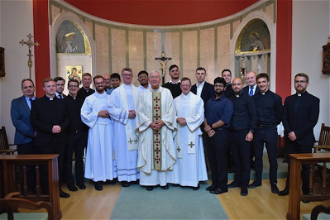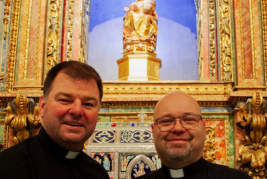Eyewitness report: Holy Week in Valladolid
Source: VIS
Experiencing the dramatic processions along the streets of Valladolid in Spain is an unforgettable experience.
The capital of the department of Castile y Leon has for many centuries held the tradition of taking the many polychrome religious statues depicting the passion out of the Churches and parading them along the streets, as an expression of penance and piety.
This year there were around 60 processions in total, led by the confraternities (guilds) that either carry or drag the statues. Many of the processions have choirs, brass bands and thumping drums accompanying the confraternities to add to the occasion.
Some of the participants to the processions actually walk barefoot in order to express the penitential aspect of the processions.
The most striking aspect of the week is the pointed hats covering many of the faces of the processions are exactly the same as those used by the Klu Klux Clan! However this is merely a coincidence. The dress used by some of the participants emphasizes anonymity.
The first procession started on Palm Sunday from the Cathedral to the Plaza Mayor (main square), with many of the first communion children taking part, in a popular but modest procession.
I participated in a procession carrying a statue of our Lady out to meet Jesus crucified out in the street on the Monday at around midnight. The event was very sombre and spiritual. An amazing choir had come to sing whilst the procession took place, whilst the many hundreds of people who had come to watch were very quiet and respectful.
Later on in the week a huge statue entered our Church along with the whole confraternity in a dramatic scene, in order to meet the statue of Our Lady.
The sermon of the last seven words of Christ happens on Maunday Thursday of Holy Week, as seven pasos (statues) pass during the sermon which continues for several hours.
The Chrism Mass in the Cathedral was liturgically amusing as despite the presence of 250 priests, someone forgot that it is usually helpful to have a lectionary ready rather than still in the sacristy if you're going to do the readings!
On Good Friday, all 32 of the pasos pass by the main square in an extended story of the passion.
This year the event was rained off half way through, leading to an interesting reinterpretation of Passion! The paso depicting the crucifixion had just passed, at which point it was covered by a plastic bag- perhaps suggesting that Christ in fact died by asphyxiation!
The other pasos fled for cover, as many of them are 16th century masterpieces, and the confraternities were extremely reluctant to let them get wet!
On Easter Sunday again in the main square Archbishop Braulio said a few words before releasing many doves free in the square.
Perhaps the best element of the week is that the passion is dramatically played out in the streets. Some of the statues themselves are masterpieces and the processions transmit the drama, pain and intensity of the passion without turning it into entertainment. People are happy to demonstrate their faith in the street with drama that shows living faith.
The beauty of the processions, the careful planning that takes place and the solemn and penitential elements also make it a rich cultural and spiritual experience.
Overall I would recommend attending the processions to anybody.
It is a shame that we do not have the same dramatic expression of the faith in England over Holy Week.
Robert is a student at the English College in Valladolid.


















